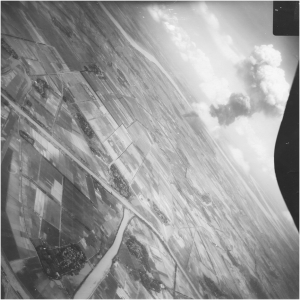Blown Slick Series#4
“… it has been decades since the last significant contribution to airpower theory. Given the shifting character of war and rapid technological change, a solid modern airpower theory will be required for the West to achieve strategic success in future conflicts.”
Reviewing Airpower Reborn;The Strategic Concepts of John Warden and John Boyd by JP ‘Spear’ Mintz
Out of the process of reading, researching, communicating with old airwing friends, and in addition reaching out for the Air Force side – leveraging the “Rats” of the Red River Valley Fighter Pilots Association, plus all the while observing the more recent past of airpower use in Desert Storm, Iraqi Freedom, etc., the emergent anti-access/area denial threat particularly in the South China Sea, and the on going issues with the F-35 and the apparent end to the A-10, I began formulation of a next series for the site. This is the back story to discussion of the evolution of fighter, attack, and strike warfare – Blown Slick–Light Attack Fast Pursuit Airpower Analysis – the series.
The term “blown slick” was coined within the ready-room context of my VA-56 Champs squadron in regard to, shall we say, battle damage assessment of our attack missions into North Vietnam.
 (On 22 July 1972, the USS Midway launched a 30 plus plane Alpha Strike to the Ca Chau buried petroleum facility just across the Red River from Hanoi. CDR Neil Harvey, Commanding Officer of the VA-56 Champs was the strike leader. Myself and Smokey Tolbert were his wingmen. As can be seen in the picture this strike created a huge cloud, visible even from Midway’s location at sea, giving the hard working flight deck crew a view of what their efforts were supporting.)
(On 22 July 1972, the USS Midway launched a 30 plus plane Alpha Strike to the Ca Chau buried petroleum facility just across the Red River from Hanoi. CDR Neil Harvey, Commanding Officer of the VA-56 Champs was the strike leader. Myself and Smokey Tolbert were his wingmen. As can be seen in the picture this strike created a huge cloud, visible even from Midway’s location at sea, giving the hard working flight deck crew a view of what their efforts were supporting.)
And then with the humor that can only emerge out of a war time environment, “blown slick” was given a double meaning by two Champ Ltjg’s – Max and Munt – with a significant and most meaningful modification: ” The Boy’s blown slick, not a knob on ’em,” implying in most certain Hong Kong Sansui stereo terms – “volumes all the way up, control knobs have been blown off, no control whatsoever.” Therein was the perfect storm reflection of the necessity of evening the strain of combat flying most evident in places like the Cubi Point Officers Club, the City of Olongapo, Hong Kong and Singapore.
The working hypothesis is that the combination of world problems/threat environments combined with emerging technology and tactical application and implied change, suggest that the application of U.S. airpower could be at a watershed moment. Decisions are pending or may already have been made that could leave all services airpower capabilities weaker rather than better able to serve our defense needs. Either way, I suggest much still needs examination.
Remembered Sky began as a way to tell the stories of myself and my friends on that ’72-’73 Vietnam war cruise on USS Midway, but the catalyst was my decision related to the
100th year anniversary of Naval Aviation to spend some time re-reading the collection  of books and articles, researching further into the details of that 100 years, and finally re-treading my own years within that 100 year long story. Stated often, a significant element was my continuing fascination with the complete history of the Battle of Midway which includes the evolution of carrier warfare and the 1930’s Fleet Battle Problems.
of books and articles, researching further into the details of that 100 years, and finally re-treading my own years within that 100 year long story. Stated often, a significant element was my continuing fascination with the complete history of the Battle of Midway which includes the evolution of carrier warfare and the 1930’s Fleet Battle Problems.
Key operational threads and several distinctly focused series have been used to tell the stories: 1) Air War Vietnam 1972; 2) the overall aircraft carrier environment (to include significant naval aviation history; 3) the near disaster on Midway’s flight deck on the night of 24 Oct, 1972; 4) the ’72 Christmas time frame; and finally 5) Operation Homecoming and the return home of our POW’s.
Moving along these paths of exploration of naval aviation’s beginnings, the distinct passage for all U.S. airpower that was the air war in Vietnam, and the somewhat different tracks that the Air Force and Navy followed post Vietnam on into Desert Storm and Iraqi Freedom, I began to first sense and then finally acknowledge that for me, with my own experiences and aeronautical engineering education, I was developing very distinct questions, arguments, opinions, and outright disagreement with significant aspects of the analysis and conclusions about airpower being offered by many of the current crop of well respected academic/historian/military analysts.
Some noted researchers/authors seemed to have selectively ignored critical historical aspects and bypassed key elements that seemingly did not support their conclusions. Many times I came upon this in the midst of what at first appeared excellent analysis. But the missing/sometimes erroneous pieces and logic gave pause to reflect and then start to question the writers’ overall effort and its validity. Additionally, I found some sources with significant information and insight that appeared most pertinent to today’s issues such as airpower use in irregular warfare, or offering well researched and thought out criticism of today’s technical decisions that are in essence being overlooked or buried, never to be considered.
That questioning of ” the world recognized brains,” combined with my own experience, and discussions with those of my time period, along with a recent bit of research and analysis (used in a future post) I conducted as a paid consultant focusing on potential testing and training scenarios for the F-35, all together convinced me that the next step for Remembered Sky should be a move from air warfare storytelling to air warfare analysis. And thus Blown Slick; Light Attack Fast Pursuit Airpower Analysis by Boris.
The telling of 40+ year old war stories has served as a stake in the ground, and a catalyst for some different thought, if you will. This new series will attempt to tease out through a mosaic of articles on separate but overlapping subjects what the future holds given the nature of today’s emerging warfare environment: 1) War at Sea in an Anti-Access/Area Denial scenario with high threat capability such as that of China; along with 2) the seeming persistence of the ISIS-type battlefield with both strike and CAS requirements; and the growing dark cloud of 3) possible conventional air/land war in Ukraine.
The first few posts in this new series have been intended to frame current and emerging issues in tactical fast mover aviation in context of the terminology and events of an older time as a jumping off point. With this fourth post in the series, Blown Slick concludes an informal first phase and begins a move forward into more focused analysis on the elements judged to have impact on current and evolving airpower issues.
In conclusion…
What Blown Slick – Light Attack Fast Pursuit Airpower Analysis intends to do is leverage what I think I know, where I’ve been, and what I’ve found, to present a mosaic of elements that appear to have importance for application of airpower in the future. What I think will be different from other pieces of work is the intersection of ideas from the multiple sources and lines of thought. Remembered Sky to date has been mostly told as a naval air story. Blown Slick starts there but will address the future of airpower from multiple perspectives. Article subjects will include impact over time of aircraft/mission design and trade-offs, impact of fifth generation aircraft – specifically what happens with the F-35, China’s evolving defense capability, the emergent operational concept of joint operational access or its predecessor theoretical construct of AirSea Battle, the problems of close air support in an irregular warfare environment, and how provision of operationally realistic training effects US airpower application. Key thoughts from others will also be discussed with links for reader personal pursuit.
After Vietnam, the Air Force had to take seriously training for non-Nuclear-centric war. This resulted in the Red Flag training events. After Desert Storm, the Navy had to recognize the transition from concern with the Soviet Navy and then move into the joint campaign context. Post 9-11 warfare in Iraq and Afghanistan, both services have had to come to grip with “war amongst the people.” For the future – more of the same AND recognition that CAS is singularly important AND concurrently, preparation for conflict in an anti-access area denial (A2/AD) threat environment that could occur in the South China Sea – return to war-at-sea – is most definitely a joint thing.
Stealth, millions of lines of code, helmets costing $400,000, big bucks…what’s a mother to do?
And so …“Blown Slick Light Attack Fast Pursuit Airpower Analysis by Boris”
Taking a shot at what being an attack pilot, fighter pilot, strike fighter pilot, or whatever you call them in this future, will be about – some ventured thought.
The series has begun for your amusement and reflection. As always critique and comments always welcome.
To Be Continued





